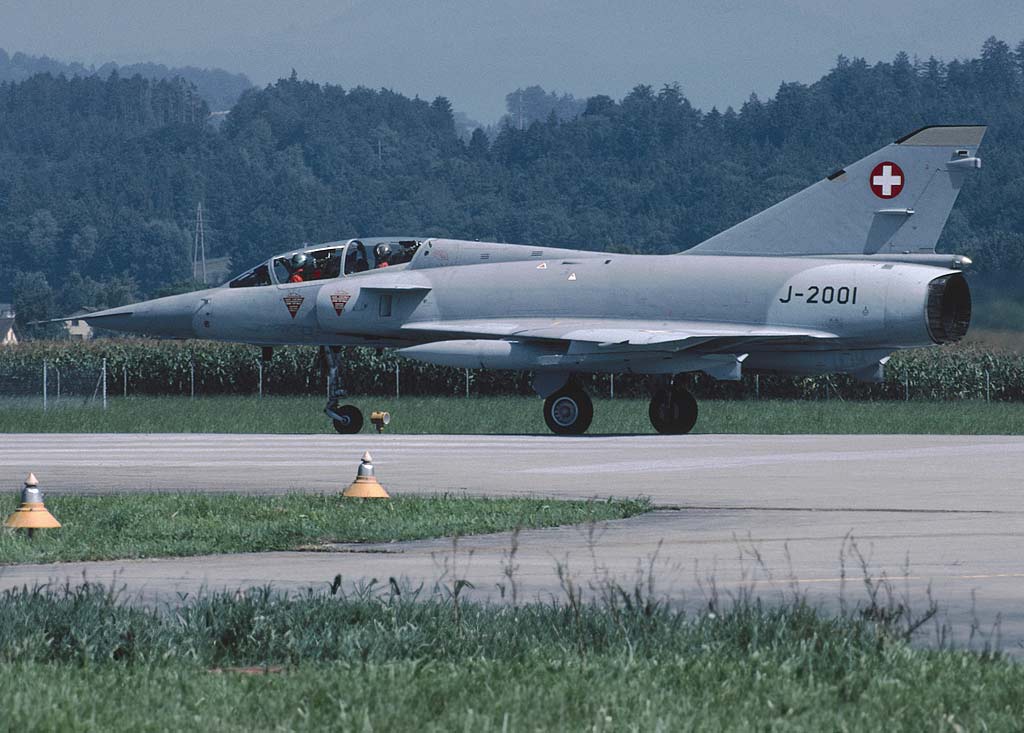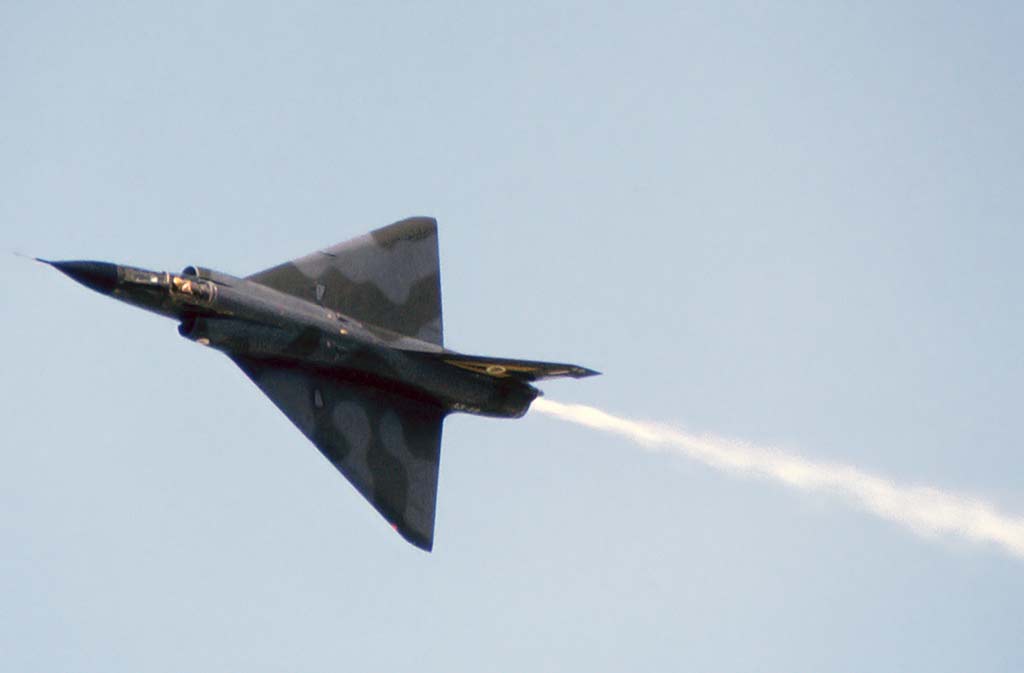The Dassault Mirage III is an iconic French supersonic fighter jet, excelling in interception and ground attack roles thanks to its high speed.
In brief
The Dassault Mirage III is a single-engine, supersonic fighter aircraft designed and produced by French manufacturer Dassault Aviation. Making its first flight on 17 November 1956, it became the first European combat aircraft to achieve Mach 2 in horizontal flight. Featuring a delta wing design, it was powered by a SNECMA Atar turbojet engine with afterburner, allowing for speeds up to Mach 2.2. The Mirage III was equipped for various roles, including interception, ground attack, and reconnaissance, with armament options such as air-to-air missiles, cannons, and bombs. Its advanced avionics for the time included radar, navigation, and electronic warfare systems, making it a versatile and effective platform in a variety of operational scenarios.

History of the Development of the Dassault Mirage III:
In the context of the Cold War and the rapid advancements in aviation technology, France sought to develop a supersonic aircraft capable of fulfilling multiple roles, including interception and tactical support. The Dassault Mirage III was born out of this necessity, conceived by Dassault Aviation in the early 1950s. The French government’s requirement for a versatile, high-performance fighter led to the program’s launch, spearheaded by Marcel Dassault and his team.
The Mirage III was a direct evolution of the Mirage I prototype, incorporating lessons learned and technological advancements to meet the demanding specifications. On 17 November 1956, the Mirage III made its maiden flight, marking a significant milestone in European aviation by achieving supersonic speeds and showcasing its potential as a multirole combat aircraft.
Design of the Dassault Mirage III
The Mirage III’s design was revolutionary at the time, featuring a delta wing configuration that provided excellent high-speed performance and maneuverability. The aircraft had a length of 15 meters (49 feet) and a wingspan of 8.22 meters (27 feet), with a maximum takeoff weight of 13,700 kilograms (30,203 pounds). The choice of a delta wing was influenced by the need for high-speed flight stability and efficient aerodynamics at both supersonic and subsonic speeds.
Powered by the SNECMA Atar 9C turbojet engine, capable of producing up to 13,500 pounds of thrust with afterburner, the Mirage III was designed for simplicity and reliability. Its airframe was constructed using lightweight materials, such as aluminum alloys and titanium, to enhance performance and durability.
The Mirage III introduced advanced avionics for its time, including radar for air-to-air combat and navigation, an autopilot system, and electronic countermeasures to improve survivability. The aircraft’s armament was versatile, capable of carrying a mix of air-to-air missiles, a 30mm DEFA cannon, and ground-attack munitions, making it adaptable to various mission profiles.
However, the design also had drawbacks, such as limited internal fuel capacity, which affected its range, and the high landing speeds required due to the delta wing design.
Performance of the Dassault Mirage III
The Mirage III distinguished itself with impressive performance metrics. It could reach a maximum speed of Mach 2.2 (approximately 2,350 km/h or 1,460 mph) and had an operational ceiling of over 17,000 meters (55,775 feet). The aircraft’s range was approximately 2,400 kilometers (1,491 miles) with external fuel tanks, and it could climb at a rate of 83.3 meters per second (16,405 feet per minute).
Comparatively, the Mirage III held its own against contemporaries like the American McDonnell Douglas F-4 Phantom II and the Soviet MiG-21. While the F-4 Phantom II offered better payload capacity and range, the Mirage III excelled in maneuverability and climb rate, making it a formidable adversary in air-to-air combat.
Variants of the Dassault Mirage III
The versatility of the Mirage III design led to the development of numerous variants, each tailored to specific requirements:
- Mirage IIIA: The initial production version, optimized for the interception role.
- Mirage IIIC: A single-seat all-weather interceptor variant equipped with radar and armed with air-to-air missiles.
- Mirage IIIE: An improved version with enhanced avionics and ground-attack capabilities.
- Mirage IIIR: A dedicated reconnaissance variant with specialized cameras and sensors.
Each variant offered improvements in performance, avionics, and mission versatility, reflecting the aircraft’s adaptability to evolving military needs.

Military Use and Combat of the Dassault Mirage III
The Dassault Mirage III saw extensive military use and combat across multiple continents, serving in the air forces of over 20 countries. Its combat debut occurred during the Six-Day War in 1967, where Israeli Mirage IIIs played a crucial role in achieving air superiority. The aircraft’s speed, agility, and firepower allowed it to dominate aerial engagements and perform effective ground-attack missions.
Throughout its service life, the Mirage III participated in numerous conflicts, including the Yom Kippur War, the Falklands War, and the South African Border War. Its performance in these conflicts demonstrated the aircraft’s effectiveness in both air-to-air combat and precision strike roles.
Competing aircraft during its operational period included the F-4 Phantom II, MiG-21, and the British Electric Lightning. Despite facing newer and more advanced adversaries, the Mirage III maintained its reputation as a reliable and potent fighter.
The Mirage III was also sold to various countries, strengthening military ties and establishing France as a significant arms exporter. While many air forces have retired the aircraft, replacing it with more modern fighters like the Dassault Mirage 2000 and the Rafale, its legacy persists in the form of upgraded variants and continued use in limited capacities.
The Dassault Mirage III stands as a landmark in aviation history, symbolizing the innovation and excellence of French aerospace engineering. Its development marked a significant leap forward in combat aircraft design, offering a blend of speed, versatility, and firepower that was unparalleled at the time. The Mirage III’s legacy is reflected in its widespread adoption, combat record, and influence on subsequent aircraft designs. As a pioneering supersonic fighter, it paved the way for future generations of combat aircraft, securing its place in the annals of military aviation history.
Back to the Fighter Jet section.